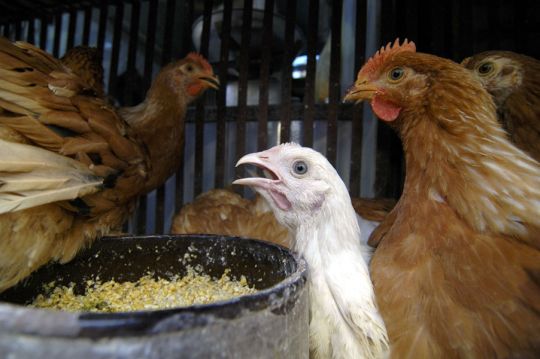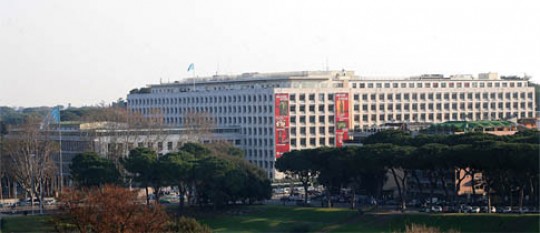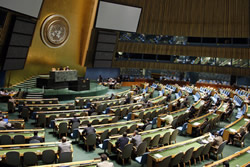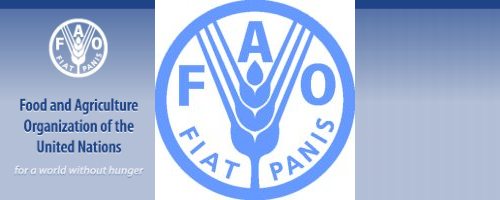UN agency warns of danger of bird flu research and urges safety measures
UN agency warns of danger of bird flu research and urges safety measures

The United Nations health agency has voiced deep concern that scientific research undertaken on a strain of highly pathogenic influenza could have negative consequences but also acknowledged that tightly-controlled studies needed to continue to limit the possibility of future risks to the global population.
In a statement released today, the World Health Organization (WHO) warned that recent studies on whether changes to the H5N1 strain of avian influenza could make it more transmissible between humans might lead to “possible risks and misuses.”
Recent media reports have noted that, if published, details of the research could provide bio-terrorists with crucial information on how to mutate the virus into a deadlier, human-to-human transmissible form.
“While it is clear that conducting research to gain such knowledge must continue, it is also clear that certain research, and especially that which can generate more dangerous forms of the virus than those which already exist, has risks,” the WHO statement warned, noting that any further research should be done “only after all important public health risks and benefits have been identified and reviewed.”
WHO also urged all research teams to fully abide by the regulations set out in the new Pandemic Influenza Preparedness Framework, which sets out a guideline to the sharing of influenza viruses with pandemic potential and the resulting benefits.
Since 2003, the H5N1 virus has killed or forced the culling of more than 400 million domestic poultry and caused an estimated $20 billion of economic damage. Although it does not infect humans often, about 60 per cent of those infected with it die. The latest death occurred earlier this year in Cambodia, which has registered eight cases of human infection this year – all of them fatal.
While H5N1 was believed to be eliminated from most of the 63 infected countries, in August 2011 the UN’s Food and Agriculture Agency (FAO) reported a surge in outbreaks of the virus, with almost 800 cases recorded between 2010 and 2011.
###
Statement
WHO concerned that new H5N1 influenza research could undermine the 2011 Pandemic Influenza Preparedness Framework
30 December 2011
The World Health Organization (WHO) takes note that studies undertaken by several institutions on whether changes in the H5N1 influenza virus can make it more transmissible between humans have raised concern about the possible risks and misuses associated with this research. WHO is also deeply concerned about the potential negative consequences. However, WHO also notes that studies conducted under appropriate conditions must continue to take place so that critical scientific knowledge needed to reduce the risks posed by the H5N1 virus continues to increase.
H5N1 influenza viruses are a significant health risk to people for several reasons. Although this type of influenza does not infect humans often, when it does, approximately 60% of those infected die. In addition, because these viruses can cause such severe illness in people, scientists are especially concerned that this type of influenza could one day mutate so it spreads easily between people and causes a very serious influenza pandemic.
Research which can improve the understanding of these viruses and can reduce the public health risk is a scientific and public health imperative. In order to enable those public health gains, countries where these viruses occur should share their influenza viruses for public health purposes while countries and organizations receiving these viruses should share benefits resulting from the virus sharing. Both types of sharing are on equal footing and equally important parts of the collective global actions needed to protect public health.
While it is clear that conducting research to gain such knowledge must continue, it is also clear that certain research, and especially that which can generate more dangerous forms of the virus than those which already exist, has risks. Therefore such research should be done only after all important public health risks and benefits have been identified and reviewed, and it is certain that the necessary protections to minimize the potential for negative consequences are in place.
In May 2011, the new Pandemic Influenza Preparedness (PIP) Framework came into effect. This Framework was adopted by all WHO Member States as a guide to the sharing of influenza viruses with pandemic potential and the resulting benefits. One specific requirement of this Framework, which pertains to influenza viruses of pandemic potential, and is in keeping with best scientific practice, is for laboratories receiving them through WHO’s Global Influenza Surveillance and Response System (GISRS) to collaborate with, and appropriately acknowledge, scientists in countries where the virus originated when initiating research.
WHO recognizes that the scientists who led the work of the new studies received their virus samples from the WHO Global Influenza Surveillance Network (GISN), which preceded GISRS, and before negotiations on the new PIP Framework began. However, now that the Framework has been adopted by all WHO Member States, WHO considers it critically important that scientists who undertake research with influenza viruses with pandemic potential samples fully abide by the new requirements.
Since the PIP Framework represents a major step forward and was agreed upon only after several years of difficult negotiations, WHO stresses that this H5N1 research must not undermine this major public health achievement. WHO will work with Member States and other key parties to ensure scientists understand the new requirements that have been agreed to with the Framework.
For more information, please contact:
Gregory Härtl
Coordinator, Media Relations, WHO
Telephone: +41 22 791 4458
Mobile: +41 79 203 6715
E-mail: hartlg@who.int
Tarik Jasarevic
Media Office, WHO
Telephone: +41 22 791 50 99
Mobile: +41 793 67 62 14
E-mail: jasarevict@who.int
###
About World Health Organization (WHO)
WHO is the directing and coordinating authority for health within the United Nations system. It is responsible for providing leadership on global health matters, shaping the health research agenda, setting norms and standards, articulating evidence-based policy options, providing technical support to countries and monitoring and assessing health trends.
In the 21st century, health is a shared responsibility, involving equitable access to essential care and collective defence against transnational threats.
WHO fulfils its objectives through its core functions:
- providing leadership on matters critical to health and engaging in partnerships where joint action is needed;
- shaping the research agenda and stimulating the generation, translation and dissemination of valuable knowledge;
- setting norms and standards and promoting and monitoring their implementation;
- articulating ethical and evidence-based policy options;
- providing technical support, catalysing change, and building sustainable institutional capacity
- monitoring the health situation and assessing health trends.
The WHO agenda
WHO operates in an increasingly complex and rapidly changing landscape. The boundaries of public health action have become blurred, extending into other sectors that influence health opportunities and outcomes. WHO responds to these challenges using a six-point agenda. The six points address two health objectives, two strategic needs, and two operational approaches. The overall performance of WHO will be measured by the impact of its work on women’s health and health in Africa.
1. Promoting development
During the past decade, health has achieved unprecedented prominence as a key driver of socioeconomic progress, and more resources than ever are being invested in health. Yet poverty continues to contribute to poor health, and poor health anchors large populations in poverty. Health development is directed by the ethical principle of equity: Access to life-saving or health-promoting interventions should not be denied for unfair reasons, including those with economic or social roots. Commitment to this principle ensures that WHO activities aimed at health development give priority to health outcomes in poor, disadvantaged or vulnerable groups. Attainment of the health-related Millennium Development Goals, preventing and treating chronic diseases and addressing the neglected tropical diseases are the cornerstones of the health and development agenda.
2. Fostering health security
Shared vulnerability to health security threats demands collective action. One of the greatest threats to international health security arises from outbreaks of emerging and epidemic-prone diseases. Such outbreaks are occurring in increasing numbers, fuelled by such factors as rapid urbanization, environmental mismanagement, the way food is produced and traded, and the way antibiotics are used and misused. The world’s ability to defend itself collectively against outbreaks has been strengthened since June 2007, when the revised International Health Regulations came into force.
3. Strengthening health systems
For health improvement to operate as a poverty-reduction strategy, health services must reach poor and underserved populations. Health systems in many parts of the world are unable to do so, making the strengthening of health systems a high priority for WHO. Areas being addressed include the provision of adequate numbers of appropriately trained staff, sufficient financing, suitable systems for collecting vital statistics, and access to appropriate technology including essential drugs.
4. Harnessing research, information and evidence
Evidence provides the foundation for setting priorities, defining strategies, and measuring results. WHO generates authoritative health information, in consultation with leading experts, to set norms and standards, articulate evidence-based policy options and monitor the evolving global heath situation.
5. Enhancing partnerships
WHO carries out its work with the support and collaboration of many partners, including UN agencies and other international organizations, donors, civil society and the private sector. WHO uses the strategic power of evidence to encourage partners implementing programmes within countries to align their activities with best technical guidelines and practices, as well as with the priorities established by countries.
6. Improving performance
WHO participates in ongoing reforms aimed at improving its efficiency and effectiveness, both at the international level and within countries. WHO aims to ensure that its strongest asset – its staff – works in an environment that is motivating and rewarding. WHO plans its budget and activities through results-based management, with clear expected results to measure performance at country, regional and international levels.
###
> UN Food and Agriculture Organization (FAO).
The Food and Agriculture Organization of the United Nations (FAO) is an intergovernmental organization and has 191 Member Nations, two associate members and one member organization, the European Union. Achieving food security for all is at the heart of FAO’s efforts – to make sure people have regular access to enough high-quality food to lead active, healthy lives.

FAO’s mandate is to raise levels of nutrition, improve agricultural productivity, better the lives of rural populations and contribute to the growth of the world economy.
The Food and Agriculture Organization of the United Nations (FAO) is working with its Members and the entire international community for achievement of the Millennium Development Goals.
These eight goals – each with specific targets and indicators – are based on the United Nations Millennium Declaration, signed by world leaders in September 2000. They commit the international community to combating poverty, hunger, disease, illiteracy, environmental degradation, and discrimination against women.
![]()
The eight Millennium Development Goals are:
Goal 1: Eradicate extreme poverty and hunger
Goal 2: Achieve universal primary education
Goal 3: Promote gender equality and empower women
Goal 4: Reduce child mortality
Goal 5: Improve maternal health
Goal 6: Combat HIV/AIDS, malaria and other diseases
Goal 7: Ensure environmental sustainability
Goal 8: Develop a Global Partnership for Development
* More information at UN Food and Agriculture Organization (FAO)
###
> United Nations (UN).
 The United Nations was established on 24 October 1945 by 51 countries committed to preserving peace through international cooperation and collective security. Today, nearly every nation in the world belongs to the UN: membership totals 192 countries.
The United Nations was established on 24 October 1945 by 51 countries committed to preserving peace through international cooperation and collective security. Today, nearly every nation in the world belongs to the UN: membership totals 192 countries.
When States become Members of the United Nations, they agree to accept the obligations of the UN Charter, an international treaty that sets out basic principles of international relations. According to the Charter, the UN has four purposes:
- to maintain international peace and security;
- to develop friendly relations among nations;
- to cooperate in solving international problems and in promoting respect for human rights;
- and to be a centre for harmonizing the actions of nations.
###
* The above story is adapted from materials provided by United Nations (UN)
** More information at United Nations (UN)





















